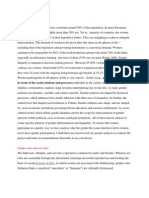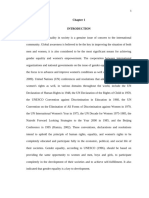Baseline Definitions of Key Concepts and Terms: UNESCO's Gender Mainstreaming Implementation Framework
Uploaded by
bloomzainBaseline Definitions of Key Concepts and Terms: UNESCO's Gender Mainstreaming Implementation Framework
Uploaded by
bloomzainUNESCO’s Gender Mainstreaming Implementation Framework
Baseline definitions of key concepts and terms
Gender refers to the roles and responsibilities of men and women that are created in our
families, our societies and our cultures. The concept of gender also includes the
expectations held about the characteristics, aptitudes and likely behaviours of both
women and men (femininity and masculinity). Gender roles and expectations are learned.
They can change over time and they vary within and between cultures. Systems of social
differentiation such as political status, class, ethnicity, physical and mental disability, age
and more, modify gender roles. The concept of gender is vital because, applied to social
analysis, it reveals how women’s subordination (or men’s domination) is socially
constructed. As such, the subordination can be changed or ended. It is not biologically
predetermined nor is it fixed forever.
Sex describes the biological differences between men and women, which are universal
and determined at birth.
Gender Analysis is the collection and analysis of sex-disaggregated information. Men
and women both perform different roles. This leads to women and men having different
experience, knowledge, talents and needs. Gender analysis explores these differences so
policies, programmes and projects can identify and meet the different needs of men and
women. Gender analysis also facilitates the strategic use of distinct knowledge and skills
possessed by women and men.
Sex-Disaggregated Data is data that is collected and presented separately on men and
women.
Gender Equality means that women and men have equal conditions for realizing their
full human rights and for contributing to, and benefiting from, economic, social, cultural
and political development.
Gender equality is therefore the equal valuing by society of the similarities and the
differences of men and women, and the roles they play. It is based on women and men
being full partners in their home, their community and their society.
Gender Equity is the process of being fair to men and women. To ensure fairness,
measures must often be put in place to compensate for the historical and social
disadvantages that prevent women and men from operating on a level playing field.
Equity is a means. Equality is the result.
Empowerment is about people -both women and men- taking control over their lives:
setting their own agendas, gaining skills, building self-confidence, solving problems and
developing self-reliance. No one can empower another: only the individual can empower
herself or himself to make choices or to speak out. However, institutions including
international cooperation agencies can support processes that can nurture self-
empowerment of individuals or groups.
Last updated April 2003
UNESCO’s Gender Mainstreaming Implementation Framework
Gender Division of Labour is the result of how each society divides work among men
and among women according to what is considered suitable or appropriate to each
gender.
Women in Development (WID) The WID approach aims to integrate women into the
existing development process by targeting them, often in women-specific activities.
Women are usually passive recipients in WID projects, which often emphasize making
women more efficient producers and increasing their income. Although many WID
projects have improved health, income or resources in the short term, because they did
not transform unequal relationships, a significant number were not sustainable. A
common shortcoming of WID projects is that they do not consider women’s multiple
roles or that they miscalculate the elasticity of women’s time and labour. An other, is that
such projects tend to by blind to men’s roles and responsibilities in women’s
(dis)empowerment.
The biggest difference between WID and GAD is that WID projects traditionally were
not grounded in a comprehensive gender analysis. The GAD approach is gender-analysis
driven.
There is definitely a need for women-specific and men-specific interventions at times.
These complement gender initiatives. Research shows that the success of both sex-
specific and gender activities is directly linked with the depth of the gender analysis that
informs them.
Gender and Development (GAD) The GAD approach focuses on intervening to address
unequal gender relations which prevent inequitable development and which often lock
women out of full participation. GAD seeks to have both women and men participate,
make decisions and share benefits. This approach often aims at meeting practical needs as
well as promoting strategic interests. A successful GAD approach requires sustained
long-term commitment.
Practical Needs refer to what women (or men) perceive as immediate necessities such as
water, shelter and food.
Strategic (Gender) Interests. Interventions addressing strategic gender interests focus on
fundamental issues related to women’s (or, less often, men’s) subordination and gender
inequities. Strategic gender interests are long-term, usually not material, and are often
related to structural changes in society regarding women’s status and equity. They
include legislation for equal rights, reproductive choice, and increased participation in
decision-making. The notion of “strategic gender needs”, first coined in 1985 by Maxine
Molyneux, helped develop gender planning and policy development tools, such as the
Moser Framework, which are currently being used by development institutions around
the world.
NB: The purpose of introducing such distinctions between needs is to alert the
programme specialist to the importance of addressing the structural challenges to
Last updated April 2003
UNESCO’s Gender Mainstreaming Implementation Framework
women’s empowerment. It is not to lock women’s realities and experiences into rigid and
pre-set notions of what is a strategic need versus what responds to a practical need. For,
in many instances, changes in women’s practical conditions of life have an effect on
power relations between men and women within the community.
Gender-mainstreaming is a process rather than a goal. Efforts to integrate gender into
existing institutions of the mainstream have little value for their own sake. We
mainstream gender concerns to achieve gender equality and improve the relevance of
development agendas. Such an approach shows that the costs of women’s marginalization
and gender inequalities are born by all.
UN ECOSOC describes gender mainstreaming as “the process of assessing the
implications for women and men of any planned action, including legislation, policies or
programmes, in all areas and at all levels. It is a strategy for making women’s as well as
men’s concerns and experiences an integral dimension of the design, implementation,
monitoring and evaluation of policies and programmes in all political, economic and
societal spheres so that women and men benefit equally and inequality is not
perpetuated. The ultimate goal is to achieve gender equality”. (ECOSOC Agreed
Conclusions 1997/2)
Gender-responsive objectives are programme and project objectives that are non-
discriminatory, equally benefit women and men and aim at correcting
gender imbalances.
Literacy Gender Parity Index (GPI) is the ratio of the female to male adult literacy rates
which measures progress towards gender equity in literacy and the level of learning
opportunities available for women in relation to those available to men. It serves also as
a significant indicator of the empowerment of women in society.
References:
- March, C., Smyth I., Mukhopadhyay M., A Guide to Gender-Analysis Frameworks;
Oxfam, 1999
- Status of Women Canada, Gender-Based Analysis: A guide for policy-making, 1996
- UNIFEM; Focusing on Women –UNIFEM’s expereince in mainstreaming, 1993
- Molyneux, Maxine ‘Mobilisation without Emancipation? Women’s Interests, States
and Revolution in Nicargua’; Feminist Studies II, 2, 1985.
- OECD, DAC Source Book on Concepts and Approaches Linked to Gender Equality
Last updated April 2003
You might also like
- Introduction To International Development CH6No ratings yetIntroduction To International Development CH614 pages
- Kiira Jamal: Peminggiran Kelompok Perempuan Dalam Perencenaan Kebijikan PublikNo ratings yetKiira Jamal: Peminggiran Kelompok Perempuan Dalam Perencenaan Kebijikan Publik14 pages
- Gender and Development (Concepts and Key-Terms) - Part Three (The Rest of The Last Class-19.01.2021)No ratings yetGender and Development (Concepts and Key-Terms) - Part Three (The Rest of The Last Class-19.01.2021)4 pages
- Additional reading-ISSUES AND CONCEPTS IN GENDER MAINSTREAMINGNo ratings yetAdditional reading-ISSUES AND CONCEPTS IN GENDER MAINSTREAMING21 pages
- Gender and Development 2 Refers To The Socially Determined Ideas and Practice As To What It Means To Be Female or MaleNo ratings yetGender and Development 2 Refers To The Socially Determined Ideas and Practice As To What It Means To Be Female or Male13 pages
- UNICEF Gender Transformative ProgrammingNo ratings yetUNICEF Gender Transformative Programming27 pages
- Handout 1 of Promoting Gender Equality NewNo ratings yetHandout 1 of Promoting Gender Equality New32 pages
- APC - 20190327 ChildFund Gender Position Paper - FINAL DRAFT 3No ratings yetAPC - 20190327 ChildFund Gender Position Paper - FINAL DRAFT 36 pages
- 05b6-1714:documents (1) /gender Development (Reflection)0% (1)05b6-1714:documents (1) /gender Development (Reflection)3 pages
- Frequently Asked Questions About Gender EqualityNo ratings yetFrequently Asked Questions About Gender Equality5 pages
- Gad Lecture 1 Introduction On Gender Gender Concepts and DefinitionsNo ratings yetGad Lecture 1 Introduction On Gender Gender Concepts and Definitions38 pages
- Refreshing Your Knowledge: Gender AnalysisNo ratings yetRefreshing Your Knowledge: Gender Analysis10 pages
- Unit 9 Contemporary Issues in Livestock EnterprisesNo ratings yetUnit 9 Contemporary Issues in Livestock Enterprises29 pages
- New Perspectives and Challenges For Women's Studies at Aden University, YemenNo ratings yetNew Perspectives and Challenges For Women's Studies at Aden University, Yemen9 pages
- Gender and Development (GAD) : B P S U M C C B100% (2)Gender and Development (GAD) : B P S U M C C B55 pages
- On Education and Media - Closing The Gender Gap in Media RepresentationNo ratings yetOn Education and Media - Closing The Gender Gap in Media Representation20 pages
- Gender-Sensitivity: A Training Manual For Sensitizing Education Managers, Curriculum and Material Developers and Media Professionals To Gender ConcernsNo ratings yetGender-Sensitivity: A Training Manual For Sensitizing Education Managers, Curriculum and Material Developers and Media Professionals To Gender Concerns3 pages
- Equity: A Venerable Group of Rights and Procedures To Provide Fairness, Unhampered by TheNo ratings yetEquity: A Venerable Group of Rights and Procedures To Provide Fairness, Unhampered by The8 pages
- ANG LR Sep13 Angola Positive Masculinity in AngolaNo ratings yetANG LR Sep13 Angola Positive Masculinity in Angola25 pages
- Gender and Disability Mainstreaming MannualNo ratings yetGender and Disability Mainstreaming Mannual34 pages
- Gender responsive climate smart agriculture finalNo ratings yetGender responsive climate smart agriculture final33 pages
- Gender parity and its impact on the banking sector in the U.K.: A Guide for Businesses and GovernmentsFrom EverandGender parity and its impact on the banking sector in the U.K.: A Guide for Businesses and GovernmentsNo ratings yet



























































